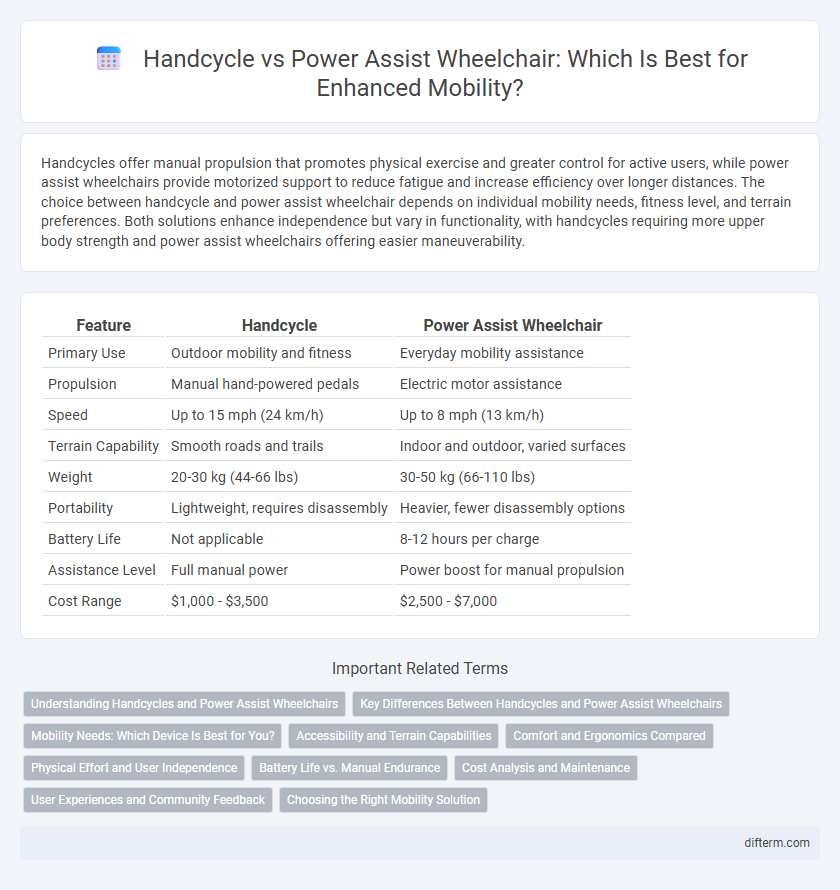Handcycles offer manual propulsion that promotes physical exercise and greater control for active users, while power assist wheelchairs provide motorized support to reduce fatigue and increase efficiency over longer distances. The choice between handcycle and power assist wheelchair depends on individual mobility needs, fitness level, and terrain preferences. Both solutions enhance independence but vary in functionality, with handcycles requiring more upper body strength and power assist wheelchairs offering easier maneuverability.
Table of Comparison
| Feature | Handcycle | Power Assist Wheelchair |
|---|---|---|
| Primary Use | Outdoor mobility and fitness | Everyday mobility assistance |
| Propulsion | Manual hand-powered pedals | Electric motor assistance |
| Speed | Up to 15 mph (24 km/h) | Up to 8 mph (13 km/h) |
| Terrain Capability | Smooth roads and trails | Indoor and outdoor, varied surfaces |
| Weight | 20-30 kg (44-66 lbs) | 30-50 kg (66-110 lbs) |
| Portability | Lightweight, requires disassembly | Heavier, fewer disassembly options |
| Battery Life | Not applicable | 8-12 hours per charge |
| Assistance Level | Full manual power | Power boost for manual propulsion |
| Cost Range | $1,000 - $3,500 | $2,500 - $7,000 |
Understanding Handcycles and Power Assist Wheelchairs
Handcycles provide a manual, pedal-powered option designed for active users seeking exercise and enhanced mobility, benefiting from ergonomic hand pedals and customizable frames. Power assist wheelchairs combine electric motors with manual wheelchairs, offering motorized support that reduces user effort while maintaining maneuverability and independence. Both devices cater to different mobility needs, with handcycles emphasizing physical activity and power assist wheelchairs focusing on ease of movement in daily environments.
Key Differences Between Handcycles and Power Assist Wheelchairs
Handcycles offer manual propulsion through hand-crank mechanisms, enabling greater exercise and physical engagement, whereas power assist wheelchairs combine manual wheels with battery-powered motors that amplify the user's pushing force for easier navigation. Handcycles typically require more upper body strength and are designed for outdoor use with higher speeds and better terrain handling, while power assist wheelchairs prioritize enhanced mobility indoors and on flat surfaces with a focus on comfort and convenience. The key differences lie in propulsion method, user effort, terrain adaptability, and intended usage scenarios, impacting user autonomy and physical activity levels.
Mobility Needs: Which Device Is Best for You?
Handcycles offer enhanced speed and cardiovascular exercise, ideal for users seeking active mobility and outdoor independence, while power assist wheelchairs prioritize ease of maneuverability and stamina for users with limited upper body strength. Evaluating personal mobility needs, terrain types, and desired activity levels helps determine which device delivers optimal freedom and comfort. Accessibility features such as battery range, weight capacity, and user control options are crucial for selecting the best mobility solution.
Accessibility and Terrain Capabilities
Handcycles offer enhanced accessibility on varied terrains including gravel and uneven trails due to their manual propulsion and larger wheels, which provide superior maneuverability and control. Power assist wheelchairs, while offering significant ease of movement and reduced physical exertion, may face limitations on rough off-road surfaces where battery power and wheel design influence performance. Users prioritizing rugged outdoor accessibility often prefer handcycles, whereas power assist wheelchairs excel in urban environments with smoother surfaces.
Comfort and Ergonomics Compared
Handcycles offer superior ergonomic design through adjustable handlebars and seating positions that promote natural body alignment, reducing strain during prolonged use. Power assist wheelchairs provide enhanced comfort with cushioned seats and customizable support systems tailored to individual needs, improving posture and minimizing pressure points. Both options prioritize user comfort but differ in their approach, with handcycles emphasizing active engagement and power assist wheelchairs focusing on passive support.
Physical Effort and User Independence
Handcycles require greater physical effort as they rely on upper-body strength for propulsion, promoting cardiovascular fitness and muscle engagement. Power assist wheelchairs reduce physical exertion by providing motorized support, enhancing user independence and enabling longer travel distances with less fatigue. Users seeking active exercise benefits may prefer handcycles, while those prioritizing ease of mobility and autonomy often choose power assist wheelchairs.
Battery Life vs. Manual Endurance
Handcycles typically offer extended battery life designed to support longer rides with less frequent recharging, making them ideal for users seeking sustained mobility with reduced manual effort. Power assist wheelchairs combine manual propulsion with battery-powered assistance, enhancing endurance by reducing user fatigue but generally require more frequent recharging due to higher energy consumption. Comparing battery life and manual endurance highlights the trade-off between the robust support of power assist technology and the greater independence afforded by handcycles.
Cost Analysis and Maintenance
Handcycles typically have lower initial costs compared to power-assist wheelchairs, making them a more budget-friendly option for users seeking manual propulsion with enhanced speed. Maintenance expenses for handcycles tend to be minimal, involving basic upkeep like tire inflation, brake adjustments, and occasional chain lubrication. Power-assist wheelchairs demand higher investment with complex electronics and motors, resulting in increased maintenance costs due to battery replacements, firmware updates, and professional servicing.
User Experiences and Community Feedback
Handcycle users frequently highlight enhanced physical exercise and outdoor engagement, praising its ability to promote cardiovascular health and independence in varied terrains. Power assist wheelchair users emphasize improved maneuverability and reduced fatigue during daily activities, noting significant benefits in urban environments and crowded spaces. Community feedback reveals a preference for handcycles among active users seeking fitness and adventure, while power assist wheelchairs are favored by individuals prioritizing convenience and extended mobility support.
Choosing the Right Mobility Solution
Selecting the right mobility solution depends on individual needs, terrain, and activity level. Handcycles offer greater exercise benefits and outdoor independence, while power assist wheelchairs provide enhanced ease of use and support in various environments. Evaluating factors like stamina, physical strength, and lifestyle ensures optimal mobility and improved quality of life.
handcycle vs power assist wheelchair Infographic

 difterm.com
difterm.com